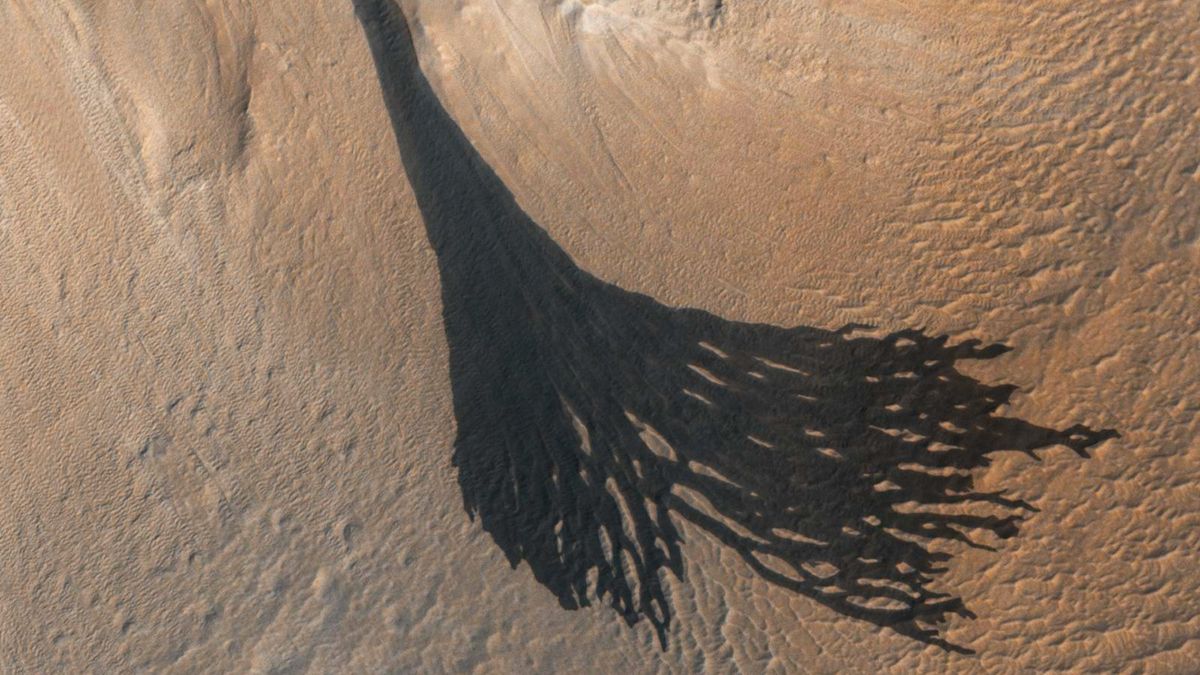Long, dark 'streaks' spotted on Mars aren't what scientists thought
Martian "slope streaks" spotted by NASA's Mars Reconnaissance Orbiter in 2017. Scientists previously thought these large, discolored features may be signs of running water.Mysterious dark streaks flowing across Mars's surface may not be the result of running water after all, a new artificial intelligenceanalysis suggests.The streaks, first observed running along Mars's cliffsides and crater walls by NASA's Viking mission in 1976, were long thought by scientists to have formed as a result of the flow of ancient water across the now mostly desiccated planet's surface.But an AI algorithm trained on slope streak observations has revealed a different origin for the streaks — likely being formed from wind and dust, not water. The findings, published May 19 in the journal Nature Communications, could have important implications for where humans choose to explore Mars, and the places they search for evidence of possible ancient life.
"That's the advantage of this big data approach," study co-author Adomas Valantinas, a planetary scientist at Brown University, said in a statement. "It helps us to rule out some hypotheses from orbit before we send spacecraft to explore."The sinewy lines are darker than the surrounding Martian ground and extend for hundreds of meters downhill. The shorter-lived of these features are called recurring slope lineae, and regularly spring up during Mars's warmer spells.This led some planetary scientists to suggest that seasonal temperature fluctuations could be causing ice or frozen aquifers to melt, or humid air to condense, sending streams of salty water trickling down the planet's craters. If this were true, it would make these regions of particular interest to future Mars missions.To investigate this, the scientists behind the study trained a machine learning algorithm on confirmed streak sightings before making it scan through 86,000 satellite images to create a map of 500,000 streak features.RELATED STORIES"Once we had this global map, we could compare it to databases and catalogs of other things like temperature, wind speed, hydration, rock slide activity and other factors." Bickel said. "Then we could look for correlations over hundreds of thousands of cases to better understand the conditions under which these features form."Using the map, the scientists found the streaks were most likely to form in places where wind speed and dust deposition was high, suggesting that they came from layers of fine dust sliding off steep slopes.Other studies have pointed to tantalizing evidence of water and even life on Mars. If the study findings hold up, they could serve as a guide to sift between the Red Planet's useful leads and its red herrings.
Sign up for the Live Science daily newsletter nowGet the world’s most fascinating discoveries delivered straight to your inbox.
#long #dark #039streaks039 #spotted #mars
Long, dark 'streaks' spotted on Mars aren't what scientists thought
Martian "slope streaks" spotted by NASA's Mars Reconnaissance Orbiter in 2017. Scientists previously thought these large, discolored features may be signs of running water.Mysterious dark streaks flowing across Mars's surface may not be the result of running water after all, a new artificial intelligenceanalysis suggests.The streaks, first observed running along Mars's cliffsides and crater walls by NASA's Viking mission in 1976, were long thought by scientists to have formed as a result of the flow of ancient water across the now mostly desiccated planet's surface.But an AI algorithm trained on slope streak observations has revealed a different origin for the streaks — likely being formed from wind and dust, not water. The findings, published May 19 in the journal Nature Communications, could have important implications for where humans choose to explore Mars, and the places they search for evidence of possible ancient life.
"That's the advantage of this big data approach," study co-author Adomas Valantinas, a planetary scientist at Brown University, said in a statement. "It helps us to rule out some hypotheses from orbit before we send spacecraft to explore."The sinewy lines are darker than the surrounding Martian ground and extend for hundreds of meters downhill. The shorter-lived of these features are called recurring slope lineae, and regularly spring up during Mars's warmer spells.This led some planetary scientists to suggest that seasonal temperature fluctuations could be causing ice or frozen aquifers to melt, or humid air to condense, sending streams of salty water trickling down the planet's craters. If this were true, it would make these regions of particular interest to future Mars missions.To investigate this, the scientists behind the study trained a machine learning algorithm on confirmed streak sightings before making it scan through 86,000 satellite images to create a map of 500,000 streak features.RELATED STORIES"Once we had this global map, we could compare it to databases and catalogs of other things like temperature, wind speed, hydration, rock slide activity and other factors." Bickel said. "Then we could look for correlations over hundreds of thousands of cases to better understand the conditions under which these features form."Using the map, the scientists found the streaks were most likely to form in places where wind speed and dust deposition was high, suggesting that they came from layers of fine dust sliding off steep slopes.Other studies have pointed to tantalizing evidence of water and even life on Mars. If the study findings hold up, they could serve as a guide to sift between the Red Planet's useful leads and its red herrings.
Sign up for the Live Science daily newsletter nowGet the world’s most fascinating discoveries delivered straight to your inbox.
#long #dark #039streaks039 #spotted #mars








